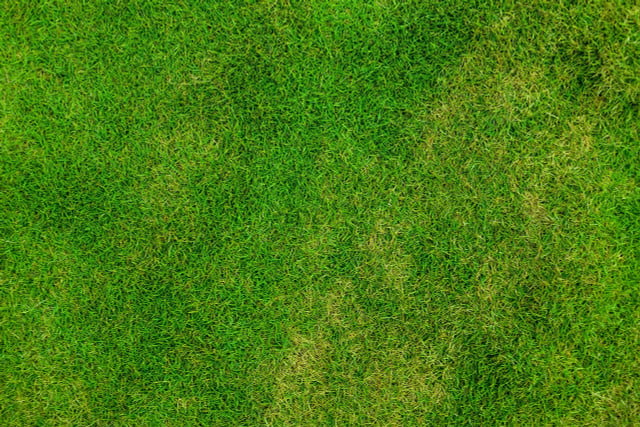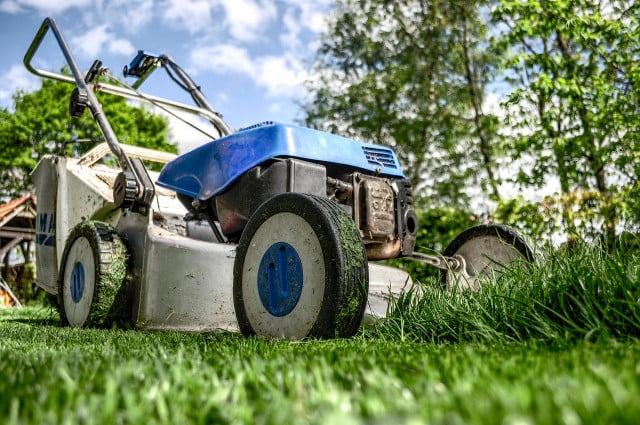Aerification is part of regular lawn care. What aerification is, how to do it and what it brings to the lawn, we explain here.
Contents
Aerify your lawn: The benefits

Lawns usually grow on sandy soils that contain both mineral and organic components. The soil pores, which carry water and air, supply the lawn with nutrients.
To ensure that it grows well in the long term, you should maintain the lawn regularly. This includes fertilizing the lawn, watering it, and also maintaining the coarse and medium pores in the soil. They are essential for the lawn to absorb water, air and nutrients.
If you don’t aerify the soil regularly, the surface of your lawn can become compacted over time: The soil is compressed by weather and frequent foot traffic, and the pores in the soil close up. The more the turf compacts, the more moss grows. This creates waterlogging and prevents air from reaching the grass roots. Eventually, the lawn will stop growing altogether and become susceptible to weeds and moss.
Aerification can help to open up these pores again and provide the lawn with the necessary nutrients in the best possible way.
What is aerification?
When you aerify, you loosen the soil pores by poking holes in the soil. When you scarify, you also cut the soil – but there are differences:
- When you scarify the lawn, you can remove dead materials and the so-called lawn felt from the lawn. Here, the blade of the scarifier scores the turf a few millimeters deep. However, experts and amateur gardeners disagree on how effective the procedure really is. We have more information on the advantages and disadvantages of scarifying in our guide Scarifying the lawn: The right time, instructions and possible risks.
- When aerating, on the other hand, you loosen up the deeper-lying turf by making holes in the ground. This allows the air in the soil to circulate better and microorganisms and worms to settle better in the soil.
When is aerification useful?
There are a few signs that can tell you that the soil in your lawn is too compacted:
- If you find a lot of broadleaf plantain or moss on your lawn, it indicates that your soil is compacted.
- If the soil smells musty, it may mean that there is not enough oxygen in it. Without enough oxygen, roots can’t grow properly and microorganisms are less active.
- You notice after rain or watering that water pools and doesn’t percolate properly into the soil? This can be a sign that your soil is too compacted.
- Also, if your lawn is not growing well in places, you should aerify it.
- You can measure the soil density with a so-called penetrometer. These meters determine the resistance to penetration into the soil. It is best to ask your local dealer if they carry penetrometers.
- In principle, all soils compact over time. However, clay and loam soils are affected particularly quickly. If you keep a close eye on your lawn and maintain it regularly, you can maintain a beautiful, healthy lawn.
Aerify: the best period

In general, you should aerify your lawn at regular intervals to achieve lasting results. However, there are some things to consider:
Weather and soil conditions should be suitable. If the soil is too saturated with water, aeration can be rather disadvantageous and further deteriorate the soil quality. Therefore, after a very wet rainy period, wait a while before aerifying the lawn.
Aerify the garden soil while the grasses are growing vigorously. According to the Bavarian State Research Center for Viticulture and Horticulture, grade sprouts in the period between March and October.
For heavily used lawns, you can aerify every four weeks. For less busy lawns, it’s recommended to aerate once in the spring (March to April) and once in the fall (September to October).
Aerate lawns: Here’s how

If you want to aerate your lawn manually, it is best to use a so-called spoon. You can buy these devices cheaply in specialized stores. They work as follows:
There are hollow, cone-shaped nails on a bar with a handle that are poked into the soil. A tub catches the soil cones that are pushed up, and you can dispose of them after the aeration process.
There are different types of spoons: In addition to the hollow spoons, you can also use so-called full spoons, or cross spoons or devices that work with compressed air or water. It is best to consult a specialist dealer to find the optimal device for your lawn.
If you use a hollow spoon and aerate your lawn manually, there are a few things to keep in mind:
Mow the lawn.
Now poke holes in the affected areas of the lawn with the hollow spoon – about 200 holes per square foot. If the tine is stuck in the ground, you can shake the holes a little wider.
Fill fine-grained, washed sand into the resulting voids. This keeps the soil texture loose and encourages grass growth. You should not incorporate more than half a bucket of sand per square foot.
Water the lawn generously after you have aerified and sanded it.
Aerifiers are available for purchase at specialty stores or online at **Amazon, for example.
Aerating large lawns
Especially large lawns are very difficult to aerate by hand.
For this purpose, there are aerators, i.e. machines with which you can quickly aerate large lawns. The best thing to do is to ask your local dealer where you can borrow one of these machines.
Otherwise, there are also so-called lawn aerators (for example, online at **Amazon). These are similar to a lawn mower and can usually scarify as well as aerate.
Tip: You don’t always have to buy a new device. For example, ask a neighbor if they can lend you a Spoon or a lawn aerator. This not only saves money, but also resources.
Note: Aerators and lawn aerators require electricity. The former you fill up with gasoline, for example. It is better for the environment to use a manual spoon to aerate your lawn.


